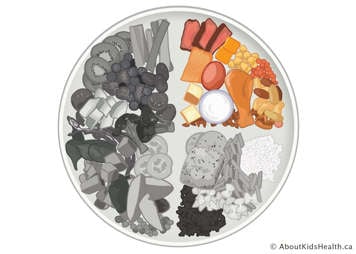What is protein?
Protein is a nutrient your body needs to grow and repair cells. It is found in animal food sources and in some plant foods. Animal sources of protein include lean cuts of meat and fish, turkey and chicken. Protein is also found in dairy products like cheeses, yogurts and milk. Eggs are another great protein food. Plant sources of protein include legumes such as edamame beans and tofu (made from soy), lentils, black beans, split peas and nuts and seeds like walnuts and sunflower seeds.
Benefits of protein
Protein helps you to feel more full when you eat a meal or snack. Protein is also needed for the growth and repair of your skin, nails and muscles; and it helps with body functions like immunity and making enzymes and hormones.

Serving tips
- Canada’s Food Guide recommends that adults and children fill one quarter of their plate with protein at meals and snacks.
- Among protein foods, have plant-based foods more often such as legumes, nuts, seeds, tofu and fortified soy beverages.
- Choose lean meats like skinless chicken breast, and trim visible fat from meat.
- Avoid processed luncheon meats, sausages and prepackaged meats that are usually high in fat and salt (sodium). If you eat them, choose sodium-reduced and lower fat varieties, if available.
- Eat at least two servings of fatty fish a week. For children, ensure that the fish does not have any bones.
- When cooking, try roasting, baking, or poaching. These methods need little or no added fat.
- If your child is over the age of two, choose low-fat dairy options by reading the Milk Fat percentage (MF %) on the label. Aim for less than 20% MF for cheese and either 1-2% for milk and yogurt. For milk alternatives and yogurts, also aim for less than 8g of sugar per serving and choose unsweetened options.
Milk products for children
- Your child should have no more than 500 mL (2 cups or 16 oz.) of milk every day.
- Children under the age of two benefit from higher-fat dairy products. Lower-fat milk products like 1% milk, skim milk or unsweetened soy beverages are a great choice after two years of age into adulthood.
- While milk is important, too much milk can be unhealthy, especially for babies over 9 months and toddlers.
- Babies under 6 months should have as much breast milk or formula as they need, as it provides them with almost all the nutrients they need during this time (except for vitamin D if a baby is only breastfeeding).
- When your child reaches 9 months, aim for them to have no more than 500 mL (2 cups or 16 oz.) of milk a day, if you are no longer breastfeeding. More milk than that in a day fills up the tummy and reduces your child's appetite for the variety of other foods that provide them with other important nutrients. Too much milk over time can also lead to iron deficiency anemia.
- Once your child shows signs that they can hold a cup (usually at around 12 months, but sometimes sooner), try to encourage them to drink milk from it. Switching from a bottle to a cup at age 12 to 18 months has been shown to decrease the chance that a child will drink too much milk.
- Have your child drink fortified unsweetened soy beverages (drinks with added vitamins and minerals) if they do not drink cow’s milk.
